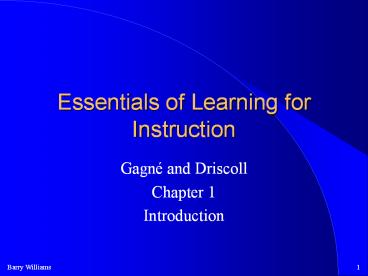Essentials of Learning for Instruction - PowerPoint PPT Presentation
Title:
Essentials of Learning for Instruction
Description:
Essentials of Learning for Instruction – PowerPoint PPT presentation
Number of Views:10
Avg rating:3.0/5.0
Title: Essentials of Learning for Instruction
1
Essentials of Learning for Instruction
- Gagné and Driscoll
- Chapter 1
- Introduction
2
The Role of the Instructor
- Provides instruction
- Set of events designed to initiate, activate,
support learning - Planned
- Delivered
3
What is learning?
- A process
- Typically involves interaction with external
environment - Inferred by a change or modification in behavior
- Persistent over time
4
Knowledge about Learning
- Through research that must be both valid and
reliable - By observational studies that may lead to
- Correlational studies show negative or positive
effects - Experimental studies show variable effects
5
Knowledge about Learning(continued)
- Experimental data yields inferences about
non-observable process of learning. - These inferences give rise to generalized
knowledge about learning (called learning
principles). - These inferences are verified by predicting
additional learning outcomes in a new situation.
6
Example of the Study of Learning .. 6
Map! What map??
7
Research Terminology
- Reliability
- addressed by repeated observations
- leads to replicable data
- Validity
- measures or evaluates what it says it does
- Controlling conditions
8
Research TerminologyInferences about internal
processes
- Use many studies to validate premise
- For example
- Research Conclusion
- Facts are learned more readily when they can
be meaningfully related by the learner, i.e. - Generalized Inference
- A story has framework / schema to hang facts
on
9
Learning Theory Basics
- Research on learning produces data
- The data accumulates and allows the formulation
of learning principles - As the knowledge grows, ways are suggested to
organize disparate facts into a single
conceptualization called a theory
10
Learning Theory(continued)
- A learning theory is designed to explain several
specific facts that have been independently
observed by relating these facts to a conceptual
model - Models are designed to generate predictions of
behavior - when predictions are not verified the theory is
either modified or rejected
11
Behaviorist Learning Theory
- 1913 E.L. Thorndike
- Law of Effect (stimulus, response, reinforcement)
- Restated by B.F. Skinner in the 50s
- Law of reinforcement
- all conditions were external or observable
12
Modern Learning Theory Its Model
- Analogous to the workings of a computer
- Information is transformed
- These transformation are called learning
processes - Model represents learning as we know it
13
Information Processing ModelLindsay Norman,
1977
Executive Control
Expectancies
Effectors
Response Generator
Environment
Sensory Register
Short-Term Memory
Long-Term Memory
Receptors
14
Purpose of Learning Theories
- Planning lessons
- Discloses the limits of what is possible
- Conducting lessons
- Guides you in an appropriate course of action
- Assessing lessons
- Makes it possible to compare what students know
and what they can demonstrate































